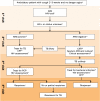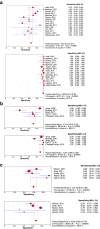Meta-analysis to compare the accuracy of GeneXpert, MODS and the WHO 2007 algorithm for diagnosis of smear-negative pulmonary tuberculosis
- PMID: 24172543
- PMCID: PMC3833313
- DOI: 10.1186/1471-2334-13-507
Meta-analysis to compare the accuracy of GeneXpert, MODS and the WHO 2007 algorithm for diagnosis of smear-negative pulmonary tuberculosis
Abstract
Background: Smear-negative pulmonary tuberculosis (SN-PTB), which is common in HIV-infected patients, is difficult to diagnose using smear microscopy alone. In 2007, the WHO developed an algorithm to improve the diagnosis and management of smear-negative tuberculosis in HIV prevalent and resource constrained settings. Implementation of the algorithm required individuals with presumptive TB to be initially evaluated using two sputum microscopy examinations followed by clinical diagnosis that may include chest X-ray and antibiotic treatment in smear-negative individuals. Since that time, the WHO has endorsed several new tests for diagnosis of tuberculosis. However, it is unclear how the new tests perform when compared to the WHO 2007 algorithm in diagnosis of SN-PTB. Using meta-analysis study design, we summarized and compared the accuracy of Xpert® MTB/Rif assay (GeneXpert) and Microscopic Observation Drug Susceptibility assay (MODS), with the WHO 2007 algorithm in the diagnosis of SN-PTB.
Methods: A systematic review and meta-analysis of publications on GeneXpert, or MODS, or the WHO 2007 algorithm for diagnosis of SN-PTB, using culture as reference test was performed. Meta-Disc software was used to obtain pooled sensitivity and specificity of the diagnostic methods. Heterogeneity in the accuracy estimates was tested by reviewing the generated forest plots, sROC curves and the Spearman correlation coefficient of the logit of true positive rate versus the logit of false positive rate.
Results: Twenty-four publications on all three diagnostic methods were meta-analyzed. The pooled sensitivity and specificity for detection of smear-negative pulmonary tuberculosis were 67% and 98% for GeneXpert, 73% and 91% for MODS, and 61% and 69% for WHO 2007 algorithm, respectively. The sensitivity of GeneXpert reduced from 67% to 54% when sub-group analysis of studies with patient HIV prevalence ≥ 30% was performed.
Conclusion: The GeneXpert, MODS, and the WHO algorithm have moderate to high accuracy for the diagnosis of SN-PTB. However, the accuracy of the tests is extremely variable. The setting and context under which the tests are conducted in addition to several other factors could explain this variability. There is therefore need to investigate these factors further. The information from these studies would inform the adoption and placement of these new tests.
Figures






References
-
- World Health Organization. Global Tuberculosis Report. 2012. Available from: http://apps.who.int/iris/bitstream/10665/75938/1/9789241564502_eng.pdf. Accessed on August 2013.
-
- Steingart KR, Ng V, Henry M, Hopewell PC, Ramsay A, Cunningham J, Urbanczik R, Perkins MD, Aziz MA, Pai M. Sputum processing methods to improve the sensitivity of smear microscopy for tuberculosis: a systematic review. Lancet Infect Dis. 2006;6(10):664–674. doi: 10.1016/S1473-3099(06)70602-8. - DOI - PubMed
-
- Murray JF. Pulmonary complications of HIV-1 infection among adults living in Sub-Saharan Africa. Int J Tuberc Lung Dis. 2005;9(8):826–835. - PubMed
Publication types
MeSH terms
LinkOut - more resources
Full Text Sources
Other Literature Sources
Medical

